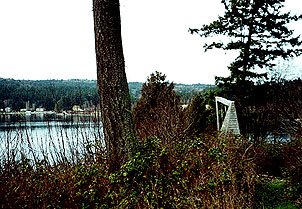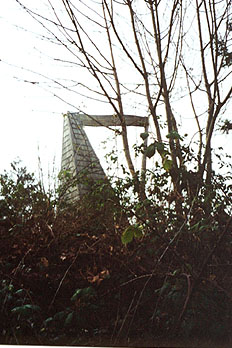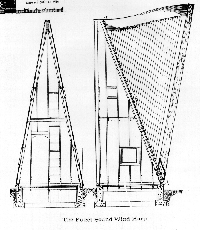














| The Giant Puget Sound Wind Harp by Ron Konzak Across Puget Sound from Seattle, near the Agate Pass Bridge at the north end of Bainbridge Island, stands a forlorn sight: a two-story harp, perilously close to an eroding cliff, surrounded by young alder trees that screen it from the very breezes that could bring it to life. |
 Windharp on the sound. |
| It was in 1982 that I first began to think about building a giant
wind-harp. I envisioned a harp over twenty feet tall, perched on the
edge of a cliff where the prevailing winds could create music on the
strings. I began to dream about building such a harp, and even began
eyeing locations on which to build it.
As I, an architect, worked at my drawing board, my thoughts often
drifted away into a fantasy land where windharps dotted the landscape,
and I found myself doodling wind-harps in the margins of my house
plans. |
|
 Windharp silhouette. |
Finally realizing that these imaginings would haunt me forever
unless I did something about them, I set about drawing a wind-harp in
true architectural form with plans, elevations, sections, and details.
My plans, drawn to the scale of 1/2" = 1', looked sensible and buildable
as I viewed them hanging on my wall. Best of all, they made me feel
like it was actually becoming a reality, especially when I built a small
scale model of the wind-harp out of illustration board and wood scraps.One day I decided to record one of the little "Brian Boru" harps that I
make, and placed it on a large Douglas fir log at the edge of the cliff,
near the spot where I wanted to build the giant harp. The day was
unsettled and breezy, and my harp immediately began to sing. After
twenty minutes rain started and I brought the harp inside. |
| Playing back
the tape I could hear the slowly changing drones of the bass strings and
the bright capricious glissandos of the treble strings, even further
enhanced by the rain pattering on the sound board as if it were a rhythm
accompaniment.I tried to imagine the sound of a harp many times its
size, played by the wind.I began to show the wind harp model, plans, and Brian Boru recordings to people, and found to my wonder that many shared my enthusiasm for a
project that had no practical application save to the delight of the
soul. A talented team of friends began to assemble. Leland Jones, soil engineer, tested the stability of the location. Ed Hagemann, structural engineer, helped me adjust the original design to accommodate the high loads which would be created by the tension of the strings. He also considered the "wind-load" factor, so we added to the plans a two-ton concrete foundation to keep the harp secure in high gales. |
|
 |
I envisioned a house-like soundbox with doors and windows so that one
could enter to listen or meditate, and look out at the water. Like a
house this had to be leakproof and strong, and designed to avoid pooling
of rain which would rot the wood.I chose to have thirty-one strings made of stainless steel aircraft control cable. They were to go through large screw-eyes to a turnbuckle
on the surface of the soundboard, to avoid having to climb to the top of
the neck for tuning. The neck would be a curved, laminated beam of twenty-one 1"x 6" fir
boards glued together. The column would be a log cut from a nearby
Douglas fir and over 22' long, tapering from 12" to 8". |
Now I had to convince our community to agree to the location I
preferred. This spot is a promontory that juts out like the prow of a
ship from the edge of the cliff. Seagulls crying and waves breaking
have always been the music here. Bald eagles, gray whales and orcas
(killer whales) are frequent visitors to these shores. This is where I
thought the wind harp would be. The evening of the day when our
community developer agreed to furnish the materials to build it, I was
sitting on the site to contemplate the project and to quietly rejoice,
when a full moon rose above the firs and let its light shine on the
cliff and the beach below. I considered it a good omen. Plotting out the site. Throughout the rainy winter I built the neck, bending the wood with two-by-fours and a primitive lever system, and gluing boards together two at a time. In the rainy spring, with the help of Bart Berg, a professional landscaper, we managed to dig the hole for the foundation, overcoming endless mud by digging a drainage trench. Two feet down, through an incredible tangle of roots, we finally reached solid bearing soil. Jeff and Charlie Bodony, brothers, carpenters and craftsmen, helped me build the forms for the concrete. And finally, again in the rain, we pumped concrete through a hose down the hill 150' into our forms.  The harp neck. The rain wouldn't let up, so I couldn't do any more work outside, and I began to lose enthusiasm. To get myself moving again, I went to the lumber yard and ordered everything I would need to build the soundbox. Finally something was really happening.As I returned day to day to work on the harp, it seemed to me a normal activity. But when I talked about it, I often left people a bit dumbfounded. Now and then even I had to wonder, what the heck was I doing? I had to learn to keep myself in touch with the magic of the wind harp, or all my efforts would become work and it would turn into just another job. The magic was always apparent when I could talk to someone discreetly about my project. The idea of creating for the sheer delight of doing it meant something to people, and almost everyone supported me with their encouragement, while many would work with me just to be involved. Not everyone really understood the project: more than once I was asked "Is there some way to shut it off, or does it just go all the time?" With good weather finally here, and too impatient to wait until a team could be gathered, one day I assembled ropes, rollers, and inclined planes, much like the pyramid builders, and got the neck out of the basement and into the back yard to be attached to the column. My neighbor, Chuck Slusser, had given me a tall straight Douglas fir for the column. I cut a tenon on the end of the neck and a mortise on top of the column so they would fit together tongue-in-groove.  Clamping the pieces together. The sides of the neck were still uneven because the glued pieces varied slightly in width. I had planned to smoothe the sides of the beam by hand with a hand-held power plane. My friend, Bruce Grant, had a better idea, and persuaded me to take it to a lumber mill that had a large planer. Total time: three minutes to end up as sleek as a bowling alley! I took it home and bolted it to the pillar, leaving the assembled structure in my driveway for what I assumed was going to be several months. Soon afterward, a warm June morning convinced me to take my power tools to the site, and in two long days I framed the sides and back of the sound-box and glued and nailed on the plywood. I'd had promises of help to assemble them to form the box, but that first warm weekend everyone else had something to do. On Monday, however, people called  The author/architecht hard at work. Finally I was at the point where there was nothing to do but erect the huge neck and column assembly, which we calculated to weigh about five hundred pounds. We didn't lack for ideas on how to do it: a boom rig, a backhoe, even a helicopter. But then we unanimously agreed that such advanced technology didn't suit the character of the project. The sailing folk and the tree movers who abound in this Northwest corner knew everything about rigging. We finally worked out a scheme with a log, a tree, and block-and-tackles. We seemed to have miles of rope festooning the cliff. For quite some time I had planned to stage an event, inviting a lot of people to share in this occasion. Now I printed up invitations and sent them to anyone who'd ever expressed an interest. The morning arrived. I had scheduled the event for noon, and at ten it was still ominously quiet. Then a Seattle TV station called for directions. Now I really got nervous and began to drink a lot of herb tea to calm myself. At 11:30 the place was still empty. What if no one came but the TV people?  Getting ready to raise the harp. At noon sixty people arrived at once, replete with smiles, enthusiasm, balloons and streamers. Eleven of the sturdiest, strongest men gathered around the neck and column assembly, hefted it and easily walked with it away from the driveway and down to the site, escorted by someone's small black dog, circling our feet and barking festively. We placed our load at the base of the sound box according to our rigging plan and proceeded to secure the main block and guide lines to the neck. It was then that I noticed that our rigging experts had failed to show up. TV cameras on me, I did what I had to do: pretended I knew what I was doing. Magically, volunteers manned the ropes and the entire assembly rose. TV cameras peered around every corner. I climbed to the top of the sound box, and the neck was let down into the socket with a magnificent "thunk!" I drove several large spikes to finally secure it, and threw my arms in the air with a shout of victory, crowd cheering and balloons ascending. We finished a few details and went home to watch ourselves on the six o'clock news.  Up she goes! All that was left was the stringing and the music. The stainless steel cables that I had bought from Boeing surplus sales were installed, but they remained silent as the days passed and I finished the outer surface of the box. Was this in fact a white elephant, a harp that did not work? I decided to restring with stainless steel banding, figuring that the thin flat steel would have more area for the wind to affect, but because the weather stayed in a long calm period, I still could not tell if the new strings were working. One sunny fall morning, Ed Hagemann, the harp's structural engineer, came over to see how the harp was progressing. As we stood inside the sound-box a soft gust of wind blew through the strings, and for the very first time we heard the wind's song. A deep low humming captured our attention and gradually flowed into a slow, majestic glissando. Other strings joined in chorus to produce a mighty crescendo and then, as if it were a deep echo, trailed off into silence. It was a performance worthy of an opera house. We cheered our approval and spontaneously danced around in the sound-box. |
|
 Windharp: size persepctive. |
In the years that followed I and others spent many hours inside the wind
harp, enchanted by its magnificent sounds. It took on a life and a
personality of its own as it reflected the moods of the wind. Someone
had a wine and cheese party there. Another someone swept it and washed
the windows, and yet another left a bottle of wine. In the interest of
truth, I have to admit that there are some people who can't tolerate the
low, hypnotic sounds and have to leave as soon as the music begins. But
most are like the woman in her 70s who parked her car by my house one
day and walked down to the harp. After an hour and a half had passed
and I was beginning to get concerned, she finally returned, admitting,
"I couldn't leave because I didn't want to miss the next melody." |
|
Eventually, though, time took its toll. Today the strings are twisted
and loose, and in summer the leaves of the aspens shield the harp from
the wind. But a renaissance is coming! A local middle school and some
other community members are raising money to move it to a better
location, away from the eroding cliff edge and open to the breeze. It
will be on a hill near a swimming pool, so that children will have
access to it. I will replace the strings; cracks and holes will be
repaired. I am so glad. It was hard to listen to the harp and not have the distinct feeling of being in the presence of a higher being. A peaceful, almost reverent aura seemed to surround the it, even when people were near. I hope my harp's new home will allow many more people the opportunity to enjoy this magical experience. You can hear Ron Konzak’s windharp at https://soundcloud.com/soundsofthedawn/ron-konzak-the-giant-puget-sound-wind-harp
For another take on a wind-sound instrument, which is not at all a harp, see The Singing, Ringing Tree sound sculpture located in Lancashire, England. |
|
Historical Harp | Folk and World Harp | Pedal Harp |
Harp Building | Harp Works | Non-Harps |
Camps & Concerts | Links | Glossary |
Donate! | Get Involved! | Contact Us | About Harp Spectrum
Copyright 2002 - 2017, Harp Spectrum All Rights Reserved